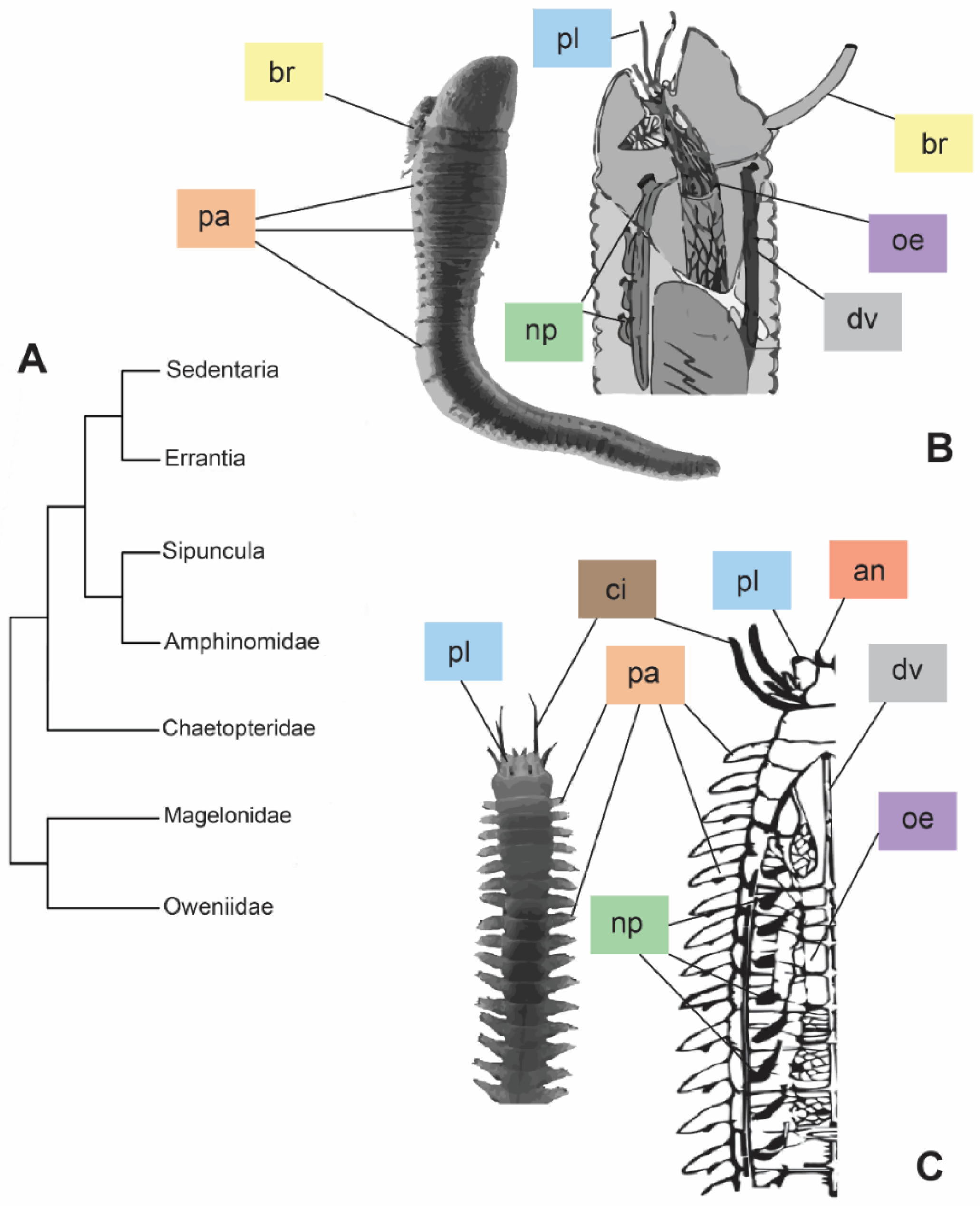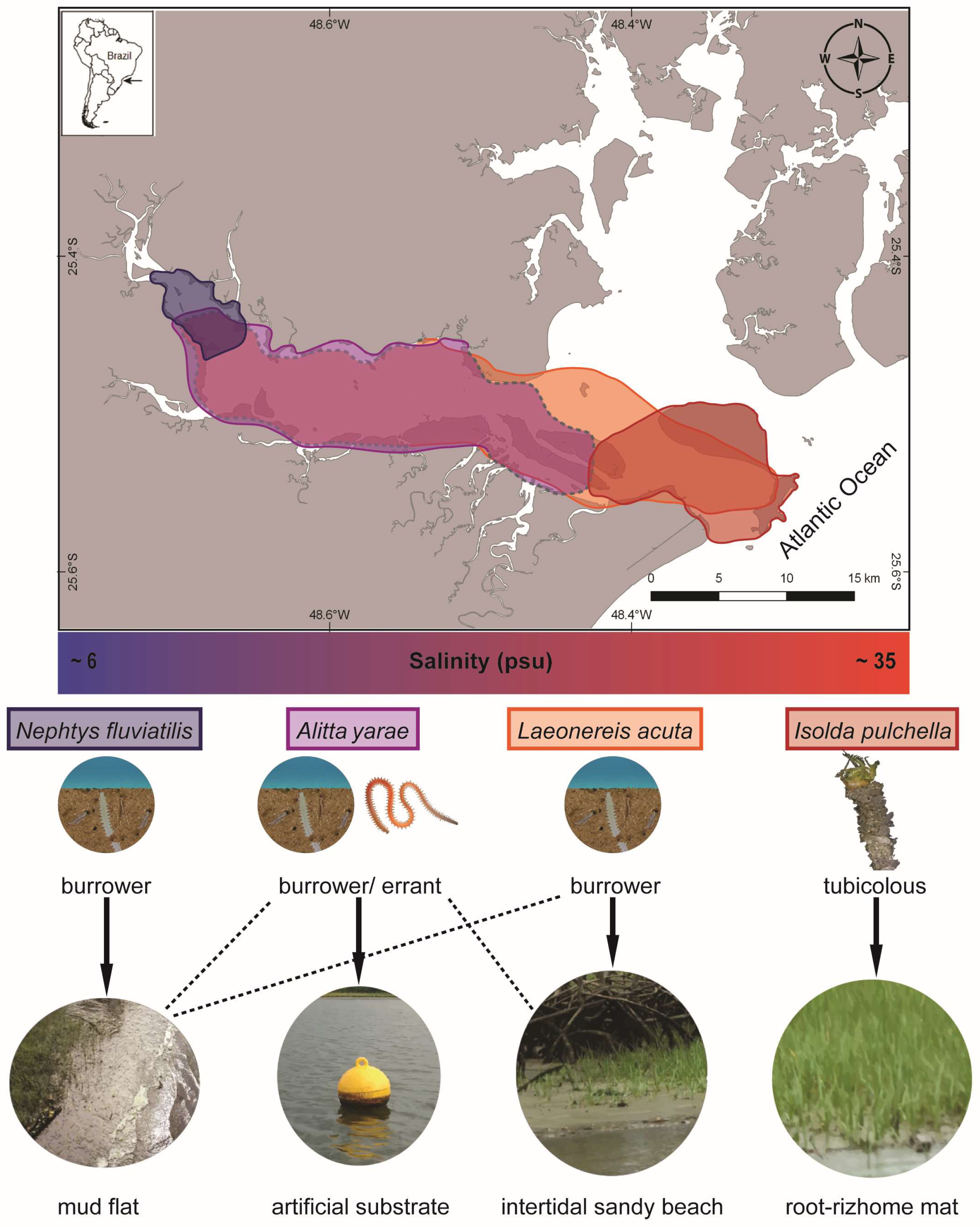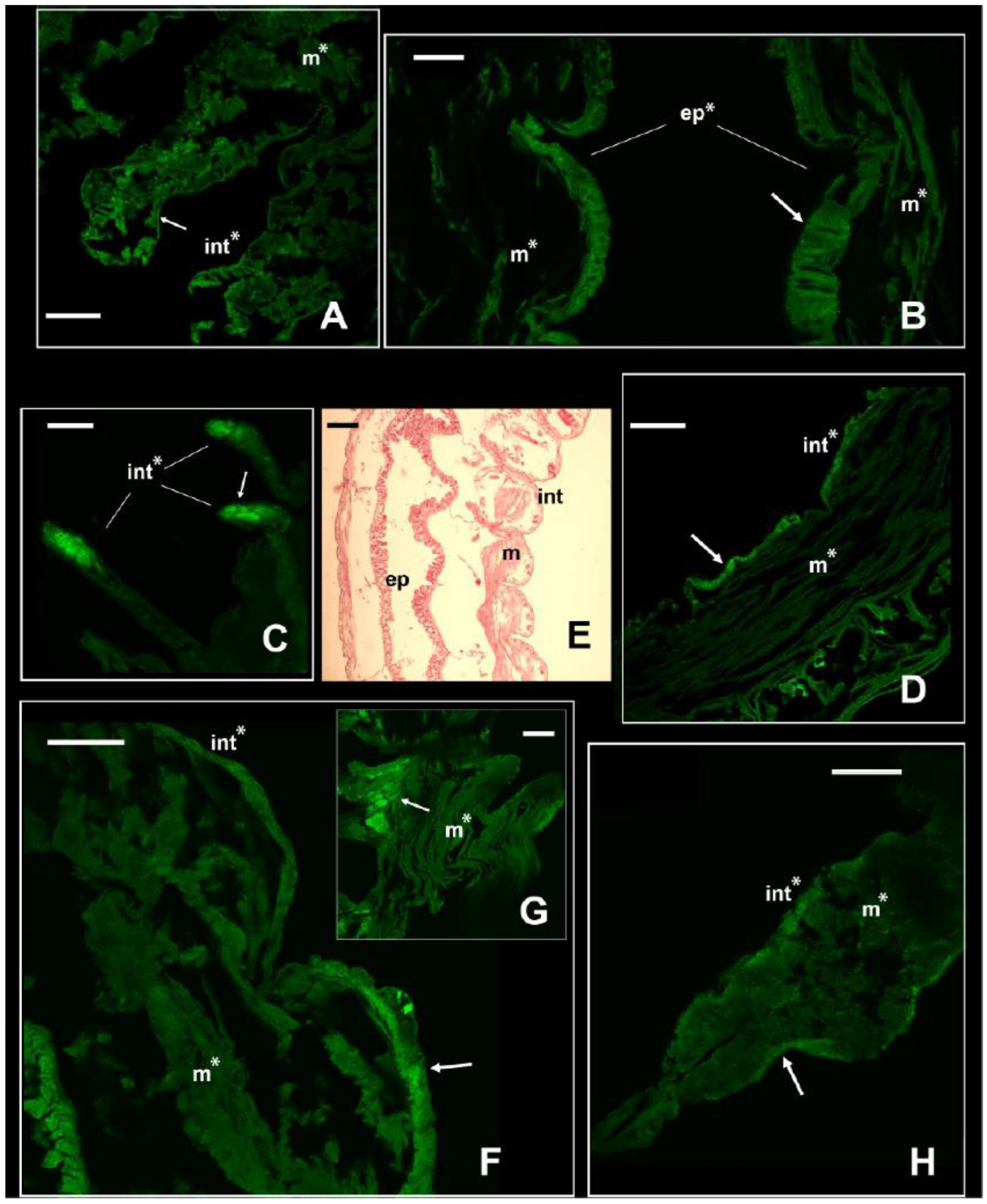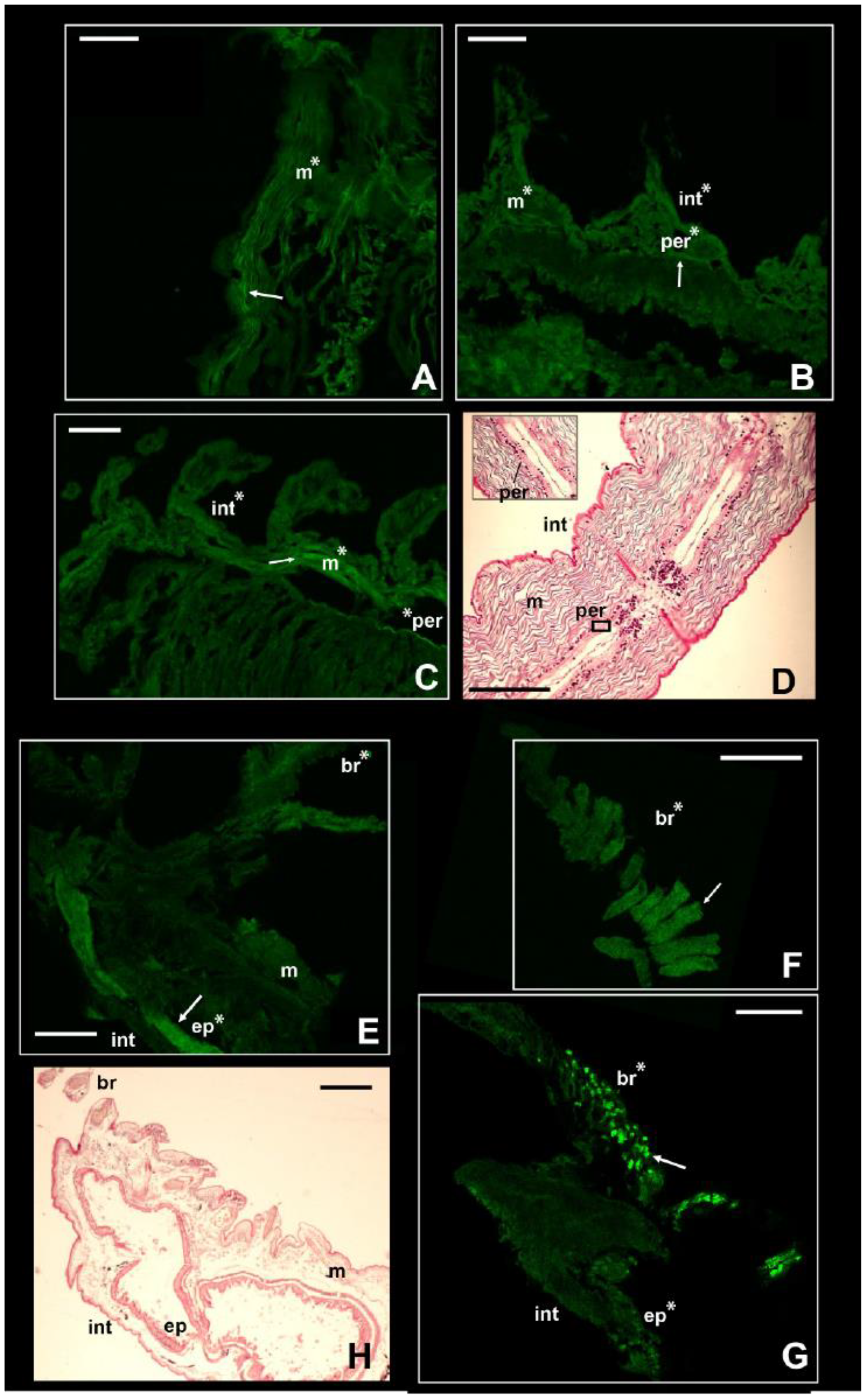First Insights into Body Localization of an Osmoregulation-Related Cotransporter in Estuarine Annelids
Abstract
Simple Summary
Abstract
1. Introduction
2. Materials and Methods
2.1. In Silico Search
2.2. Animals
2.3. Immunofluorescence
2.4. Quantification and Statistics
3. Results and Discussion
4. Conclusions
Supplementary Materials
Author Contributions
Funding
Institutional Review Board Statement
Informed Consent Statement
Data Availability Statement
Acknowledgments
Conflicts of Interest
References
- Rouse, G.; Pleijel, F. Polychaetes; Oxford University Press: Oxford, UK, 2001. [Google Scholar]
- Preston, R. Osmoregulation in Annelids. In Osmotic and Ionic Regulation: Cells and Animals; Evans, D.H., Ed.; CRC Press: New York, NY, USA; Taylor & Francis Group: New York, NY, USA, 2009; pp. 135–165. [Google Scholar]
- Weigert, A.; Bleidorn, C. Current status of annelid phylogeny. Org. Divers. Evol. 2016, 16, 345–362. [Google Scholar] [CrossRef]
- Castellano, G.C.; da Lana, P.C.; Freire, C.A. Euryhalinity of subtropical marine and estuarine polychaetes evaluated through carbonic anhydrase activity and cell volume regulation. J. Exp. Zool. Part A Ecol. Integr. Physiol. 2020, 333, 316–324. [Google Scholar] [CrossRef] [PubMed]
- Mucciolo, S.; Desiderato, A.; Leal, S.M.; Mastrodonato, M.; Lana, P.; Freire, C.A. Variability in the degree of euryhalinity of neotropical estuarine annelids. J. Exp. Mar. Biol. Ecol. 2021, 544, 151617. [Google Scholar] [CrossRef]
- Bartolomaeus, T.; Quast, B. Structure and development of nephridia in Annelida and related taxa. Hydrobiologia 2005, 535, 139–165. [Google Scholar] [CrossRef]
- Goodrich, E. The study of nephridia and genital ducts since 1895. J. Cell Sci. 1945, 86, 113–301. [Google Scholar] [CrossRef]
- Natural History Museum. Specimens (from Collection Specimens) [Artacama]. Natural History Museum. 2014. Available online: https://data.nhm.ac.uk/dataset/collection-specimens/resource/05ff2255-c38a-40c9-b657-4ccb55ab2feb (accessed on 5 October 2020).
- Tzetlin, A.B.; Filippova, A.V. Muscular system in polychaetes (Annelida). Hydrobiologia 2005, 535, 113–126. [Google Scholar] [CrossRef]
- Glasby, C.J.; Wilson, R.S.; Bakken, T. Redescription of the Indo-Pacific polychaete Neanthes pachychaeta (Fauvel, 1918) n. comb. (Annelida, Phyllodocida, Nereididae) and its synonyms. Zoosystema 2011, 33, 361–375. [Google Scholar] [CrossRef]
- Brusca, R.; Brusca, G. Invertebrates; Sinauer Associates: Sunderland, MA, USA, 2003. [Google Scholar]
- Russell, J.M. Sodium-potassium-chloride cotransport. Physiol. Rev. 2000, 80, 211–276. [Google Scholar] [CrossRef] [PubMed]
- Haas, M.; Forbush, B. The Na-K-Cl Cotransporters. J. Bioenerg. Biomembr. 1998, 30, 161–172. [Google Scholar] [CrossRef]
- Clauss, W.G. Epithelial transport and osmoregulation in annelids. Can. J. Zool. 2001, 79, 192–203. [Google Scholar] [CrossRef]
- Okada, Y. Ion channels and transporters involved in cell volume regulation and sensor mechanisms. Cell Biochem. Biophys. 2004, 41, 233–258. [Google Scholar] [CrossRef] [PubMed]
- Gamba, G.; Miyanoshita, A.; Lombardi, M.; Lytton, J.; Lee, W.S.; Hediger, M.A.; Hebert, S.C. Molecular cloning, primary structure, and characterization of two members of the mammalian electroneutral sodium-(potassium)-chloride cotransporter family expressed in kidney. J. Biol. Chem. 1994, 269, 17713–17722. [Google Scholar] [CrossRef] [PubMed]
- Payne, J.A.; Forbush, B. Alternatively spliced isoforms of the putative renal Na-K-Cl cotransporter are differentially distributed within the rabbit kidney. Proc. Natl. Acad. Sci. USA 1994, 91, 4544–4548. [Google Scholar] [CrossRef] [PubMed]
- Haas, M.; Forbush, B. The Na-K-Cl cotransporter of secretory epithelia. Ann. Rev. Physiol. 2000, 62, 515–534. [Google Scholar] [CrossRef]
- Amado, E.M.; Vidolin, D.; Freire, C.A.; Souza, M.M. Distinct patterns of water and osmolyte control between intertidal (Bunodosoma caissarum) and subtidal (Anemonia sargassensis) sea anemones. Comp. Biochem. Physiol. Part A Mol. Integr. Physiol. 2011, 158, 542–551. [Google Scholar] [CrossRef] [PubMed]
- Castellano, G.C.; Souza, M.M.; Freire, C.A. Volume regulation of intestinal cells of echinoderms: Putative role of ion transporters (Na+/K+-ATPase and NKCC). Comp. Biochem. Physiol. Part A Mol. Integr. Physiol. 2016, 201, 124–131. [Google Scholar] [CrossRef]
- Scemes, E.; Cassola, A.C. Regulatory volume decrease in neurons of Aplysia brasiliana. J. Exp. Zool. 1995, 272, 329–337. [Google Scholar] [CrossRef]
- Thonig, A.; Banta, G.T.; Gibon, S.; Kesaniemi, J.; Hansen, B.W.; Knott, K.E. Acute and chronic response to a change in salinity of the euryhaline polychaete Pygospio elegans (Claparède). J. Exp. Mar. Biol. Ecol. 2019, 516, 79–88. [Google Scholar] [CrossRef]
- Seesamut, T.; Ng, B.; Sutcharit, C.; Chanabun, R.; Panha, S. Responses to salinity in the littoral earthworm genus Pontodrilus. Sci. Rep. 2022, 12, 22304. [Google Scholar] [CrossRef]
- Dykens, J.A.; Mangum, C.P. The regulation of body fluid volume in the estuarine annelid Nereis succinea. J. Comp. Physiol. B 1984, 154, 607–617. [Google Scholar] [CrossRef]
- Zerbst-Boroffka, I.; Bazin, B.; Wenning, A. Chloride secretion drives urine formation in leech nephridia. J. Exp. Biol. 1997, 200, 2217–2227. [Google Scholar] [CrossRef] [PubMed]
- Hartmann, A.M.; Tesch, D.; Nothwang, H.G.; Bininda-Emonds, O.R.P. Evolution of the cation chloride cotransporter family: Ancient origins, gene losses, and subfunctionalization through duplication. Mol. Biol. Evol. 2014, 31, 434–447. [Google Scholar] [CrossRef] [PubMed]
- Altschul, S.F.; Gish, W.; Miller, W.; Myers, E.W.; Lipman, D.J. Basic local alignment search tool. J. Mol. Biol. 1990, 215, 403–410. [Google Scholar] [CrossRef] [PubMed]
- Edgar, R.C. MUSCLE: Multiple sequence alignment with high accuracy and high throughput. Nucleic Acids Res. 2004, 32, 1792–1797. [Google Scholar] [CrossRef] [PubMed]
- Kumar, S.; Stecher, G.; Tamura, K. MEGA7: Molecular Evolutionary Genetics Analysis Version 7.0 for Bigger Datasets. Mol. Biol. Evol. 2016, 33, 1870–1874. [Google Scholar] [CrossRef] [PubMed]
- Guindon, S.; Dufayard, J.F.; Lefort, V.; Anisimova, M.; Hordijk, W.; Gascuel, O. New algorithms and methods to estimate maximum-likelihood phylogenies: Assessing the Performance of PhyML 3.0. Syst. Biol. 2010, 59, 307–321. [Google Scholar] [CrossRef] [PubMed]
- Lefort, V.; Longueville, J.E.; Gascuel, O. SMS: Smart Model Selection in PhyML. Mol. Biol. Evol. 2017, 34, 2422–2424. [Google Scholar] [CrossRef] [PubMed]
- Marone, E.; Machado, E.C.; Lopes, R.M.; da Silva, E.T. Land-ocean fluxes in the Paranaguá Bay estuarine system, southern Brazil. Braz. J. Oceanogr. 2005, 53, 169–181. [Google Scholar] [CrossRef]
- Prodocimo, V.; Freire, C.A. The Na+, K+, 2Cl− cotransporter of estuarine pufferfishes (Sphoeroides testudineus and S. greeleyi) in hypo- and hyper-regulation of plasma osmolality. Comp. Biochem. Physiol. Part C Toxicol. Pharmacol. 2006, 142, 347–355. [Google Scholar] [CrossRef]
- Lytle, C.; Xu, J.C.; Biemesderfer, D. Distribution and diversity of Na-K-Cl cotransport proteins: A study with monoclonal antibodies. Am. J. Physiol. Cell Physiol. 1995, 269, 496–505. [Google Scholar] [CrossRef]
- D’Andrea-Winslow, L.; Strohmeier, G.R.; Rossi, B.; Hofman, P. Identification of a sea urchin Na+/K+/2Cl− cotransporter (NKCC): Microfilament-dependent surface expression is mediated by hypotonic shock and cyclic AMP. J. Exp. Biol. 2001, 204, 147–156. [Google Scholar] [CrossRef] [PubMed]
- Hiroi, J.; McCormick, S.D.; Ohtani-Kaneko, R.; Kaneko, T. Functional classification of mitochondrion-rich cells in euryhaline Mozambique tilapia (Oreochromis mossambicus) embryos, by means of triple immunofluorescence staining for Na+/K+-ATPase, Na+/K+/2Cl− cotransporter and CFTR anion channel. J. Exp. Biol. 2005, 208, 2023–2036. [Google Scholar] [CrossRef] [PubMed]
- Schindelin, J.; Arganda-Carreras, I.; Frise, E.; Kaynig, V.; Longair, M.; Pietzsch, T.; Preibisch, S.; Rueden, C.; Saalfeld, S.; Schmid, B.; et al. Fiji: An open-source platform for biological-image analysis. Nat. Methods 2012, 9, 676–682. [Google Scholar] [CrossRef] [PubMed]
- Kruskal, W.H.; Wallis, W.A. Use of ranks in one-criterion variance analysis. J. Am. Stat. Assoc. 1952, 47, 583–621. [Google Scholar] [CrossRef]
- Wilcoxon, F. Individual comparisons by ranking methods. Biom Bull. 1945, 1, 80–83. [Google Scholar] [CrossRef]
- R Core Team. R: A Language and Environment for Statistical Computing. R Foundation for Statistical Computing, Vienna, Austria. 2023. Available online: https://www.R-project.org/ (accessed on 12 October 2021).
- Scillitani, G.; Moramarco, A.M.; Rossi, R.; Mastrodonato, M. Glycopattern analysis and structure of the egg extra-cellular matrix in the Apennine yellow-bellied toad, Bombina pachypus (Anura: Bombinatoridae). Folia Histochem. Cytobiol. 2011, 49, 306–316. [Google Scholar] [CrossRef] [PubMed]
- Blake, J.A.; Grassle, J.P.; Eckelbarger, K.J. Capitella teleta, a new species designation for the opportunistic and experimental Capitella sp. I, with a review of the literature for confirmed records. Zoosymposia 2009, 2, 25–53. [Google Scholar] [CrossRef]
- Shankland, M.; Bissen, S.T.; Weisblat, D.A. Description of the Californian leech Helobdella robusta sp. nov., and comparison with Helobdella triserialis on the basis of morphology, embryology, and experimental breeding. Can. J. Zool. 1992, 70, 1258–1263. [Google Scholar] [CrossRef]
- Dunn, C.W.; Giribet, G.; Edgecombe, G.D.; Hejnol, A. Animal phylogeny and its evolutionary implications. Annu. Rev. Ecol. Evol. Syst. 2014, 45, 371–395. [Google Scholar] [CrossRef]
- Abele, D.; Gro, H.; Großpietsch, H.; Pörtner, H.O. Temporal fluctuations and spatial gradients of environmental PO2, temperature, H2O2 and H2S in its intertidal habitat trigger enzymatic antioxidant protection in the capitellid worm Heteromastus filiformis. Mar. Ecol. Prog. Ser. 1998, 163, 179–191. [Google Scholar] [CrossRef]
- Rosa, C.E.; Iurman, M.G.; Abreu, P.C.; Geracitano, L.A.; Monserrat, J.M. antioxidant mechanisms of the nereidid Laeonereis acuta (Annelida: Polychaeta) to cope with environmental hydrogen peroxide. Physiol. Biochem. Zool. 2005, 78, 641–649. [Google Scholar] [CrossRef]
- Smith, J. The nervous anatomy of the body segments of nereid polychaetes. Philos. Trans. R. Soc. Lond. 1957, 240, 135–196. [Google Scholar] [CrossRef]
- Bukanova, J.V.; Solntseva, E.I.; Skrebitsky, V.G. Cyclic nucleotides induce long-term augmentation of glutamate-activated chloride current in molluscan neurons. Cell. Mol. Neurobiol. 2005, 25, 1185–1194. [Google Scholar] [CrossRef] [PubMed]
- Pfeiffer, K.; Panek, I.; Höger, U.; French, A.S.; Torkkeli, P.H. random stimulation of spider mechanosensory neurons reveals long-lasting excitation by GABA and Muscimol. J. Neurophysiol. 2009, 101, 54–66. [Google Scholar] [CrossRef] [PubMed][Green Version]
- Stenesen, D.; Moehlman, A.T.; Schellinger, J.N.; Rodan, A.R.; Krämer, H. The glial sodium-potassium-2-chloride cotransporter is required for synaptic transmission in the Drosophila visual system. Sci. Rep. 2019, 9, 2475. [Google Scholar] [CrossRef]
- Schulte, J.T.; Wierenga, C.J.; Bruining, H. Chloride transporters and GABA polarity in developmental, neurological and psychiatric conditions. Neurosci. Biobehav. Rev. 2018, 90, 260–271. [Google Scholar] [CrossRef] [PubMed]
- Richards, K. Cuticle. In Biology of the Integument; Bereiter-Hahn, J., Matoltsy, A., Richards, K., Eds.; Springer: Berlin/Heidelberg, Germany, 1984; pp. 310–322. [Google Scholar]
- Oglesby, L.C. Volume regulation in aquatic invertebrates. J. Exp. Zool. 1981, 215, 289–301. [Google Scholar] [CrossRef]
- Pérez-Torrijos, J.; Hernández-Alcántara, P.; Solís-Weiss, V. Nephtyidae Grube, 1850. In Poliquetos (Annelida: Polychaeta) de México y América Tropical; de León-González, J., Bastida-Zavala, J., Carrera-Parra, L., García-Garza, M., Peña-Rivera, A., Salazar-Vallejo, S., Solís-Weiss, V., Eds.; Universidad Autónoma de Nuevo León: Monterrey, Mexico, 2009; pp. 317–324. [Google Scholar]
- Clark, M.E. Biochemical studies on the coelomic fluid of Nephtys hombergi (Polychaeta: Nephtyidae), with observations on changes during different physiological states. Biol. Bull. 1964, 127, 63–84. [Google Scholar] [CrossRef]
- Seaver, E.C.; Thamm, K.; Hill, S.D. Growth patterns during segmentation in the two polychaete annelids, Capitella sp. I and Hydroides elegans: Comparisons at distinct life history stages. Evol. Dev. 2005, 7, 312–326. [Google Scholar] [CrossRef]
- Haering, C.; Kanageswaran, N.; Bouvain, P.; Scholz, P.; Altmüller, J.; Becker, C.; Gisselmann, G.; Wäring-Bischof, J.; Hatt, H. Ion transporter NKCC1, modulator of neurogenesis in murine olfactory neurons. J. Biol. Chem. 2015, 290, 9767–9779. [Google Scholar] [CrossRef]
- Hübner, C.A.; Lorke, D.E.; Hermans-Borgmeyer, I. Expression of the Na-K-2Cl-cotransporter NKCC1 during mouse development. Mech. Dev. 2001, 102, 267–269. [Google Scholar] [CrossRef]
- Liang, B.; Huang, J.H. Elevated NKCC1 transporter expression facilitates early post-traumatic brain injury seizures. Neural Regen. Res. 2017, 12, 401–402. [Google Scholar] [CrossRef] [PubMed]
- Hernández-Alcántara, P.; Solís-Weiss, V. Ampharetidae Malmgren, 1866. In Poliquetos (Annelida: Polychaeta) de México y América Tropical; de León-González, J., Bastida-Zavala, J., Carrera-Parra, L., García-Garza, M., Peña-Rivera, A., Salazar-Vallejo, S., Solís-Weiss, V., Eds.; Universidad Autónoma de Nuevo León: Monterrey, Mexico, 2009; pp. 57–75. [Google Scholar]
- Grimm-Jørgensen, Y.; Ducor, M.E.; Piscatelli, J. Surface mucus production in gastropods is dependent on environmental salinity and humidity. Comp. Biochem. Physiol. A Physiol. 1986, 83, 415–419. [Google Scholar] [CrossRef]
- Heredia, R.B.; Dueñas, S.; Castillo, L.; Ventura, J.J.; Briano, M.S.; Del Rio, F.P.; Rodríguez, M.G. Autofluorescence as a tool to study mucus secretion in Eisenia foetida. Comp. Biochem. Physiol. A Mol. Integr. Physiol. 2008, 151, 407–414. [Google Scholar] [CrossRef] [PubMed]
- Verdes, A.; Gruber, D.F. Glowing Worms: Biological, Chemical, and Functional Diversity of Bioluminescent Annelids. Integr. Comp. Biol. 2017, 57, 18–32. [Google Scholar] [CrossRef] [PubMed]
- Jenvey, C.J.; Stabel, J.R. Autofluorescence and nonspecific immunofluorescent labeling in frozen bovine intestinal tissue sections: Solutions for multicolor immunofluorescence experiments. J. Histochem. Cytochem. 2017, 65, 531–541. [Google Scholar] [CrossRef]
- McIntosh, W. A Monograph of the British Marine Annelids; The Ray Society: London, UK, 1992; Volume IV, Part 1. [Google Scholar]
- D’Andrea, L.; Lytle, C.; Matthews, J.B.; Hofman, P.; Forbush, B., III; Madara, J.L. Na:K:2Cl Cotransporter (NKCC) of Intestinal Epithelial Cells: Surface expression in response to cAMP. J. Biol. Chem. 1996, 271, 28969–28976. [Google Scholar] [CrossRef]




Disclaimer/Publisher’s Note: The statements, opinions and data contained in all publications are solely those of the individual author(s) and contributor(s) and not of MDPI and/or the editor(s). MDPI and/or the editor(s) disclaim responsibility for any injury to people or property resulting from any ideas, methods, instructions or products referred to in the content. |
© 2024 by the authors. Licensee MDPI, Basel, Switzerland. This article is an open access article distributed under the terms and conditions of the Creative Commons Attribution (CC BY) license (https://creativecommons.org/licenses/by/4.0/).
Share and Cite
Mucciolo, S.; Desiderato, A.; Mastrodonato, M.; Lana, P.; Arruda Freire, C.; Prodocimo, V. First Insights into Body Localization of an Osmoregulation-Related Cotransporter in Estuarine Annelids. Biology 2024, 13, 235. https://doi.org/10.3390/biology13040235
Mucciolo S, Desiderato A, Mastrodonato M, Lana P, Arruda Freire C, Prodocimo V. First Insights into Body Localization of an Osmoregulation-Related Cotransporter in Estuarine Annelids. Biology. 2024; 13(4):235. https://doi.org/10.3390/biology13040235
Chicago/Turabian StyleMucciolo, Serena, Andrea Desiderato, Maria Mastrodonato, Paulo Lana, Carolina Arruda Freire, and Viviane Prodocimo. 2024. "First Insights into Body Localization of an Osmoregulation-Related Cotransporter in Estuarine Annelids" Biology 13, no. 4: 235. https://doi.org/10.3390/biology13040235
APA StyleMucciolo, S., Desiderato, A., Mastrodonato, M., Lana, P., Arruda Freire, C., & Prodocimo, V. (2024). First Insights into Body Localization of an Osmoregulation-Related Cotransporter in Estuarine Annelids. Biology, 13(4), 235. https://doi.org/10.3390/biology13040235





